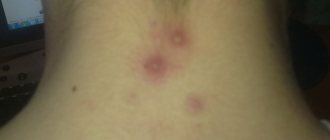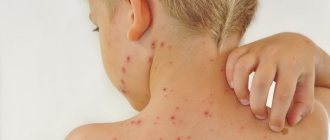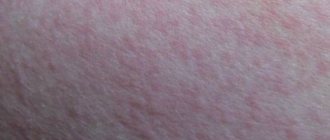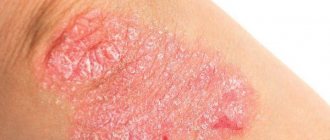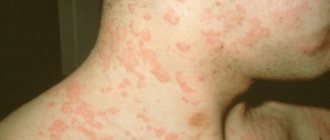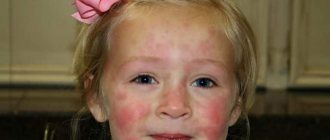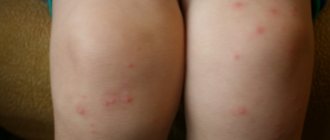What is urticarial rash?
Urticaria rash is a consequence of a complex inflammatory process that occurs in the thinnest vessels of the human body, capillaries located in the epidermal layer of the skin. This pathological process is commonly called urticarial vasculitis.
Also, this form of rash can be observed with urticaria.
What does the rash look like?
Upon visual examination, a patient with urticaria or urticarial vasculitis can see small nodules that slightly rise above the skin in the form of a papular rash (see photo). With a more severe course of the disease, the bubbles merge into a single whole and blisters appear. They have a reddish color, and are accompanied by a burning sensation and increased itching.
It should be noted that blisters with urticarial vasculitis last longer, and their treatment is sometimes difficult.
What is urticaria
Urticaria (also known as urticaria ) is an allergic disease. It is characterized by an itchy rash caused by small amounts of fluid leaking from blood vessels just below the surface of the skin.
In most cases, the disease develops suddenly and lasts from 24 to 48 hours. This is the so-called acute urticaria. If urticaria lasts longer than 6 weeks, it is considered chronic . But this condition rarely occurs.
Acute urticaria can affect anyone at any age. And its reasons often remain unknown.
Classification
This type of skin rash is usually distinguished by its etiology. They can be observed when:
- Urticaria . A disease that is caused by exposure to and entry into the human body of an allergen. This may occur due to: Use of medications.
- Use of certain foods, vegetables and fruits.
- Contact with chemical compounds.
- Allergies to mosquito bites, etc. insects
- Genetic predisposition.
- Disorders of the psychoemotional state, psychogenic nature.
- With primary vasculitis, skin rashes occur in large numbers, but they can only affect the upper layer of the epidermis. Most often, the cause of this process is: the appearance of food allergies after wearing tight clothes that contain synthetic fibers.
Are there any other signs of hives?
Most people diagnosed with acute urticaria do not feel sick. And they do not require hospital treatment.
In some cases, urticaria is a “trigger” for the development of angioedema (also known as Quincke’s edema). In this condition, some watery fluid seeps into the deep tissues under the skin, causing them to swell.
Angioedema can occur in any part of the body, but most often affects the eyelids, lips and genitals. Sometimes the tongue and throat swell. It also happens that Quincke's edema causes difficulty breathing. Fortunately, this is very rare for this disease. But remember that in case of swelling, treatment should be prescribed as quickly as possible, so do not hesitate to consult a doctor.
Symptoms of angioedema tend to last longer than blisters from hives. The swelling disappears within 3 days.
In rare cases, so-called “vasculitic urticaria” occurs. In this state, the blisters are firm to the touch and persist for more than 24 hours. They are often painful, may turn dark red in color, and leave a red, pigmented mark on the skin when they disappear.
Causes
Basically, in the etiology of this disease, it is customary to distinguish the following reasons:
- the presence in the human body of an untreated source of chronic infection;
- frequent use of steroid hormones and their analogues;
- individual characteristics of the body that cause food allergies;
- severe diabetes mellitus with high blood sugar;
- severe forms of arterial hypertension;
- any type of hepatitis;
- mononucleosis.
Other causes of rash
Rashes resembling urticaria also occur in other pathological conditions. Urticarial rash can be the result of drug intolerance, insect bites, exposure to cold or sunlight:
- Insect urticaria develops from direct exposure to saliva, poison or other waste product of insects. Symptoms: rash at the site of the bite, swelling, hyperemia. Often this type of urticaria leads to severe reactions - Quincke's edema or anaphylactic shock.
- Stress (adrenergic) urticarial rash occurs after nervous shock, excessive exercise or profuse sweating. The cause of the reaction is an increased release of the hormone adrenaline, which the body mistakenly perceives as an allergen. Symptoms: small, non-pruritic papules surrounded by a white rim. The rash on the skin does not last long and disappears without a trace.
- Cold urticaria occurs from exposure to low temperatures. Its symptoms are pronounced and develop rapidly: unprotected skin becomes covered with an itchy rash, the surrounding areas are sharply hyperemic. In severe cold allergy, chills, fever, weakness, and palpitations are observed. This is a seasonal type of rash and does not occur during the warmer months of the year.
- Solar urticaria occurs from exposure to ultraviolet rays. Accompanied by itching and burning. In severe cases, it gives symptoms of acute respiratory and vascular failure.
- Drug urticaria is an allergy to pharmacological drugs. The rash is accompanied by rhinitis and bronchospasm, in severe cases complicated by Quincke's edema or anaphylactic shock.
- Contact urticarial rash occurs at the site of direct contact with an allergen of any nature.
Symptoms
This pathological process begins with the appearance of small pink nodules and blisters , which at first are sporadic. As the disease progresses, they merge and their number increases. Very often they are located:
- on the back of the forearm;
- on the hands;
- in the lower abdomen;
- on the knees and inner thighs.
Their contents may have a slightly reddish liquid as they are formed from small capillaries.
Pain syndrome may appear . Dyspeptic disorders in the form of nausea and vomiting, and diarrhea, which can last for several days, are also observed. These symptoms are accompanied by a feeling of thirst, which occurs due to dehydration.
In more severe cases, changes occur in the central nervous system, the following appears:
- severe temporal or occipital pain;
- blood pressure rises;
- Delusional states may occur.
It is very important to differentiate urticarial rash from the consequences of urticaria. With vasculitis, blisters have clear boundaries and are hard on palpation. In the case of urticaria, the skin always remains soft and elastic, despite multiple rashes.
What does a nettle rash look like?
Hives can occur on any part of the body. Initially, swellings (blisters) appear on a small area of the skin, resembling scars. Each blister is usually surrounded by a small, reddened area of skin.
This is similar to the blisters that appear when stung by nettles, hence the name of the disease.
The blisters are usually 1-2 cm in diameter, but can vary in size. Sometimes smaller swellings located next to each other merge into larger ones. When the blister disappears, the surrounding redness remains for a while. This causes the affected area of skin to appear patchy. However, gradually the spots disappear and the skin takes on a normal appearance. Treatment boils down to removing the cause of the disease and relieving itching.
The blister “lives” for less than 24 hours. However, while some blisters on the skin fade, new ones appear. This makes the hives appear as if they are moving throughout the body.
Diagnostics
After examining and interviewing the patient, the doctor, based on the clinical picture, necessarily prescribes a histological examination of fragments of the affected skin taken for analysis. This is done to exclude the development of oncological pathologies, such as skin cancer (this disease begins with similar symptoms).
In parallel, the following is assigned:
- general blood test, where the main indicator is the level of red blood cells and ESR;
- general urine analysis;
- blood for bacterial, fungal and viral infections;
- Sometimes an ultrasound of the affected areas is prescribed.
Treatment of urticaria rash
To cure this disease, therapy must be comprehensive. The patient is prescribed:
- Antihistamines to relieve swelling and hyperemia.
- Non-steroidal anti-inflammatory drugs (if their use does not produce positive dynamics, corticosteroid hormones are prescribed).
- Plasmapheresis may be used.
In very severe cases, therapy using immunosuppressive drugs . This helps to weaken the immune system, as it negatively affects the body’s own tissues. The big disadvantage of this treatment is a decrease in immunity, as a result of which the patient can easily become infected.
Urticaria is serious
Usually not. Most people who develop symptoms of acute urticaria feel relatively well. Usually after a couple of days they return to normal life. However, they are not prescribed long-term treatment. However, the appearance of rashes and itching is in itself very unpleasant and can lead to stress.
It should be noted that in people prone to severe allergic reactions to peanuts, insect bites, etc., hives often accompany other allergy symptoms. This could be severe angioedema, difficulty breathing, collapse, etc. And in this case, treatment is already necessary, and the sooner the better.
